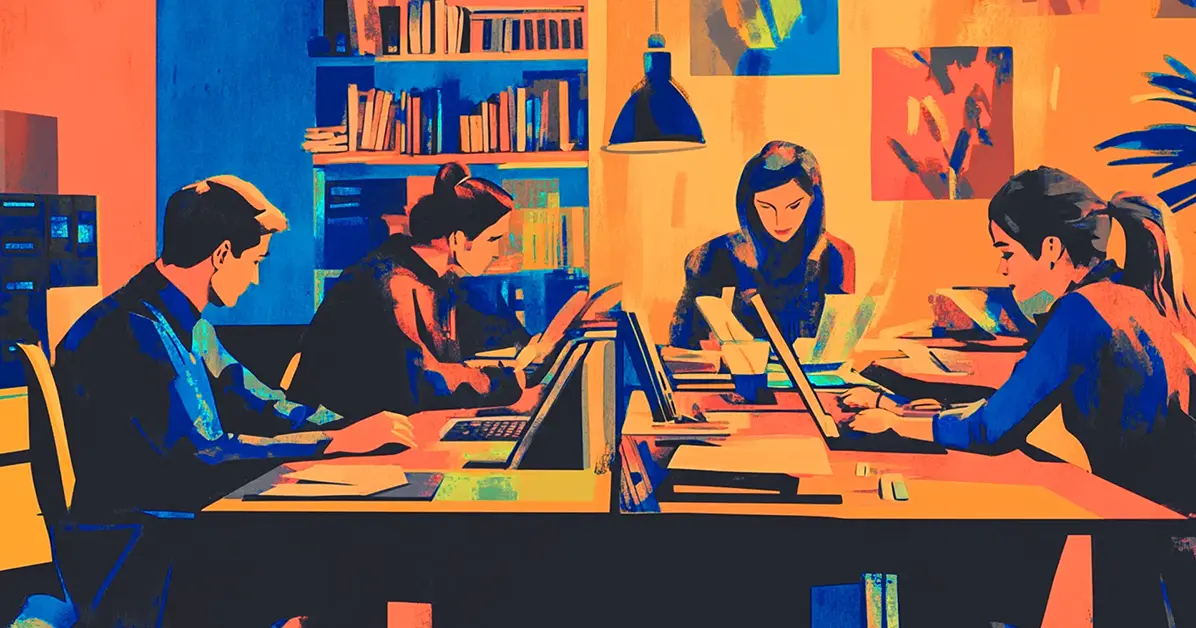Key Takeaways
- Design leaders are no longer just building tools but are now responsible for pioneering humanity's partnership with AI.
- Decades of core design principles are being inverted by AI, demanding a complete re-evaluation of how we design for trust, transparency, and control.
- With AI, design decisions have significant legal and ethical consequences, as leaders can be held accountable for real-world harm caused by their products.
- The paradox is that while design is more critical than ever, leaders must advocate for resources against executives who see AI as a replacement for human designers.
- To navigate this transformation, leaders must build their own AI literacy, create organisational stability for their teams, and collaborate with industry peers.
Every leader across every industry is grappling with the same fundamental challenges right now: learning to use AI despite not being technical, adapting workflows whilst maintaining delivery speed, and leading teams through transformation that they're learning themselves. It's the shared experience of our moment. But for design leaders, we have additional challenges that keep us awake, while others find rest. We're not just adopting new tools; we're managing the future of humanity's collaboration with non-human intelligence.
While other leaders implement AI for efficiency, design leaders are designing the very interactions to determine how effective their human team members will be in partnering with the artificial intelligence they use.
The challenge runs deeper than learning new capabilities. We're shifting from designing predictable tools that people adapt to, to creating partnerships between two intelligences (Human and AI), where both learn, evolve through each interaction, and respond differently every time. Everything we know about consistency and control is being rewritten by systems that are inherently non-deterministic.
And here's the paradox that amplifies everything: the fear, uncertainty, and overwhelm that naturally accompany this transformation are precisely what shut down creativity and experimental thinking. The exact capabilities our teams need most to design a future that doesn't yet exist but is approaching at light speed.
You're not just managing change. You're pioneering humanity's relationship with artificial intelligence itself. And you're expected to get it right whilst the ground shifts beneath your feet daily.
The Fundamental Change in How We Design
This isn't merely another platform shift or new technology adoption. Something fundamental has inverted at the core of our discipline, rendering decades of design wisdom not just outdated, but potentially counterproductive.
For decades, we've designed interfaces as intermediaries—buttons, menus, and flows that translate human intent into machine action. Users learned our systems; systems remained static. The relationship was clear: humans commanded, technology obeyed.
We're no longer designing tools that respond predictably to inputs. We're architecting ongoing relationships between humans and artificial intelligence where both learn, adapt, and make decisions in real time. Your user isn't just clicking through your predetermined user flows. They're engaging in dynamic collaboration with systems that already exceed human capability in speed, pattern recognition, and image generation.
But here's where it becomes profound: every principle we've built our careers upon is being inverted by this shift.
Reimagining core design principles for an AI world
User-centricity meant designing around human needs. Now we're designing effective Human+AI partnerships where success depends on collaboration between two forms of intelligence.
Consistency was our cornerstone—same input, same output. Generative AI is the complete reverse: designed to produce different outputs from identical inputs.
Hierarchy helped users build understanding by focusing on what matters. But as AI capabilities rapidly improve, the traditional hierarchy of human judgment over machine suggestion is radically shifting power dynamics.
User control remains essential, but users don't have full control over AI systems. Instead, we must design transparency layers that give users meaningful control over their part in the partnership.
Accessibility should improve for physical disabilities as AI adapts interfaces in real-time. But cognitive disabilities face new risks from AI systems that might overwhelm or misinterpret needs.
Usability has been redefined entirely. Success isn't just task completion; it's whether humans can effectively partner with intelligent systems that reason differently than they do.
This inversion demands we reassess everything we do with fresh eyes. Design systems must be completely reimagined with components that enable trust-building: interfaces that reveal AI decision-making processes, show what data influenced its recommendations, provide nuanced privacy controls, and offer feedback mechanisms for effective human-AI collaboration.
The research challenge is equally transformative. Traditional user research tested predictable flows. You could run five user sessions and identify patterns because the interface remained constant. But AI-powered experiences generate unique responses for each interaction. The complexity of testing non-deterministic experiences requires deeper insights, larger sample sizes, and entirely new methodologies for identifying patterns within AI-generated variability.
Which brings us to an uncomfortable truth about what we're now responsible for.
The human impact: Why your design decisions matter more than ever
When the Robodebt algorithm failed to account for non-full-time employment, it sent incorrect debt notices to hundreds of thousands of people, garnishing vulnerable people's social security and even leading to several suicides. If that system had simple transparency that explained the decisions and the data being used, it would have been obvious that errors were being made.
When Trivago's algorithm optimised for profit over accuracy, it misled millions of consumers about hotel pricing, resulting in a $44.7 million fine from the ACCC and $30 million in consumer losses. When Air Canada's chatbot gave incorrect bereavement fare information to a grieving customer, the airline was held liable for the misinformation despite arguing the chatbot was “a separate legal entity responsible for its own actions.”
These aren't hypothetical scenarios. They're happening in production systems designed by teams just like yours, right now.
Here are simple, undeniable facts.
Without deliberate interventions by product teams, AI will be biased, AI will breach privacy, and AI will make decisions that users can't understand.
Here's what no one tells you: when your AI system causes harm, you, along with Data and Engineering, will be called into the meeting with the legal team and could be held responsible.
Design has always been the voice of our human users; the advocate for their needs. We must now meet the moment by learning to represent and protect them against algorithmic bias, privacy transgressions, and giving them the ability to make informed choices through effective transparency.
The interface that collects data without explaining how it's used. The recommendation that doesn't reveal why it was suggested. The feedback mechanism that's too buried for users to correct AI assumptions. The failure of complex transparency components to allow users to understand and make choices for themselves.
Every time you design an AI interaction, you're making decisions that could empower or harm real people.
When these systems fail—and they will—you won't be able to claim ignorance. You designed the pathways that allowed the harm to occur. The regulatory investigation, the class action lawsuit, and the Senate inquiry. Your design decisions will be scrutinised line by line. You'll need to explain your AI's decision-making, how you tested it and what you did to reduce the risks.
This responsibility extends beyond individual harm to systemic consequences. We're establishing interaction patterns that will influence how millions of people experience their empowerment or diminishment in the age of AI. The decisions you make about interaction patterns, feedback mechanisms, and control structures will shape whether humans remain capable partners with AI or become dependent consumers of algorithmic outputs.
Yet just as we're grappling with this unprecedented responsibility, we face an existential battle for the resources we need to fulfil it.
The battle for resources: How design leaders can advocate for your team
You're sitting in the budget meeting when your CEO says, “Now that AI can generate designs and analyse user feedback, why do we still need such a large design team?” The CFO nods, pulling up a slide showing potential cost savings from “AI-enabled efficiency gains.” Your stomach drops as you realise the next sixty seconds will determine whether your colleagues still have jobs next quarter.
Here's the brutal paradox: just as design becomes more critical than ever, executives see AI as a way to reduce human involvement in design. They're calculating cost savings from eliminating the very capabilities that prevent catastrophic AI failures.
The data tells a sobering story. Trust in AI isn't starting low—it's actively collapsing as adoption increases. KPMG's longitudinal study shows trust levels were higher before ChatGPT than after, with Australia falling 16 percentage points below the global average. McKinsey's analysis reveals customers experiencing poor AI interactions are 2.2x more likely to churn, with 53% reducing spending immediately after a single bad AI experience.
Meanwhile, your CFO is calculating cost savings from reducing the design capabilities that prevent these customer losses.
BCG's research shows 75% of AI initiatives fail due to user adoption and trust issues, not technology limitations. The 25% that succeed have comprehensive design capabilities focused on human-AI collaboration. Organisations implementing proper AI design principles see 6x higher revenue growth, whilst companies with transparency features see 70% increases in user confidence.
But these outcomes require capabilities your current team doesn't have. AI-native startups are reaching unicorn status in 2 years versus 9 years for traditional companies. They're succeeding because they invest in design from day one, whilst 47% of Australian CEOs believe their current business models won't survive the decade.
The brutal mathematics: $400K annually for specialised AI design roles versus potential $2-5M in revenue loss from customer churn that poor AI implementations create. The executives who understand this will lead the next decade. Those who don't will spend it explaining to shareholders why competitors captured their market share while they focused on short-term cost savings.
This creates the central tension of your leadership: advocating for expanded design capabilities whilst everyone around you believes AI should reduce the need for human design thinking. You're fighting for resources to fulfil responsibilities no one fully understands yet.
Which brings us to the ultimate leadership challenge.
Navigating the unknown as design leaders: A framework for moving forward
You wake up every morning to a world that's different from yesterday. ChatGPT launched less than three years ago, and look where we are now. You're supposed to have answers, be the steady leader your team looks to for direction. But you're learning everything in real-time whilst pretending you know what you're doing.
This is by far and away the challenge of our generation. No leader in human history has navigated transformation at this speed, with stakes this high, into a future this unknowable. You're not just managing change—you're pioneering leadership for an era where the only certainty is that everything you think you know will be different tomorrow.
Your impossible daily reality: You need to build your own AI literacy whilst delivering projects at the same speed and quality as before. There's no time to stop and learn—you're googling “AI design best practices” at 2 am whilst your team expects you to guide them through tools that didn't exist six months ago.
Simultaneously, you're developing your team's AI adoption strategy—people, processes, tools—whilst fighting for training budget from executives who think AI means you need fewer people, not more skilled ones. Your designers are scared their creativity will be automated away. Your researchers question whether their methodologies still matter. Everyone's looking to you for reassurance you can't honestly give.
The cross-functional nightmare amplifies everything. Product wants to move fast with AI features. Engineering is implementing AI-first development. Data Science is building models without design input. Everyone's moving at different speeds with different approaches, creating chaos in product teams when you most need coherence.
But here's the leadership paradox: fear and uncertainty shut down precisely the capabilities your team needs most: creative problem-solving, experimental thinking, and collaborative innovation.
The magnitude of change is paralysing the very mindset required to navigate it successfully.
You're trying to create psychological safety in genuinely unsafe conditions. You're building confidence in your team whilst battling your own imposter syndrome. You're making long-term investments with short-term information. You're maintaining human-centred values whilst everything becomes increasingly automated.
Meanwhile, design leaders are responsible for understanding how to design AI experiences that build trust rather than destroy it; navigating ethical implications that didn't exist in any design education. You're stewarding humanity's relationship with artificial intelligence whilst your team delivers quarterly OKRs.
The way forward for design leaders: Three essential actions
The magnitude of this challenge demands intentional response, but not paralysis. These actions provide the foundation for leading through unprecedented transformation.
1. Build your own AI literacy—both practical and ethical
The impossible expectation of learning whilst leading requires a dual approach. You can't guide your team through AI adoption without personal fluency in the tools. You also can't fulfil your responsibilities to design AI that meets users' needs and minimises harm, without understanding bias detection, privacy implications, and transparency design. When regulatory scrutiny arrives, you need to demonstrate you understood the risks and acted appropriately.
2. Build adaptive capacity whilst your team continues to deliver
Here's the brutal reality: your team needs to master entirely new ways of working whilst delivering at the same pace as before. There's no pause button. No learning sabbatical. No gentle transition period. They're building the plane whilst flying it, and the turbulence is only getting worse.
The fear and uncertainty this creates isn’t just uncomfortable—it’s actively destructive. They shut down the experimental thinking and creative problem-solving your team needs most right now. When people feel unsafe, they revert to what they know, clinging to familiar processes precisely when innovation is most critical.
But here's what successful teams are discovering: you can create profound stability and radical innovation simultaneously. The secret isn't choosing between safety and experimentation. It's understanding that people can handle dramatic change in some dimensions if they have unshakeable foundations in others.
Think of it as building an organisation with three distinct metabolisms:
Layer 1 – Never changes: Your design principles, vision, and human-centred values become the only solid ground. When everything else feels uncertain, these become the fixed points your team can rely on.
Layer 2 – Slow, thoughtful evolution: Your frameworks, practices, and workflows that get systematised and scaled from successful Layer 3 experiments. This evolves slowly enough that people develop competence and confidence, but fast enough to remain relevant. This is where you build “change resilience”—the protocols that help people navigate uncertainty without becoming overwhelmed.
Layer 3 – Rapid experimentation: Operational experiments with AI-augmented ways of working; new tools, new human+AI workflows, new collaboration patterns. Lessons are shared monthly with decisions about which successful experiments get scaled to Layer 2. Your tools and methods can iterate at sprint speed because they're contained within stable foundations and reliable frameworks.
Cross-functional coordination is crucial: When Product, Engineering, and Data teams operate with identical three-layer structures and monthly synthesis meetings, you build the shared literacy essential for coherent collaboration rather than chaotic experimentation.
The capability requirement: Foundational AI literacy for everyone, but specialised expertise where it matters most – transparency design, non-deterministic research methodologies, human-AI collaboration patterns.
The psychological safety mechanism: Openly sharing challenges and near-misses creates learning opportunities rather than blame cycles. When people feel safe admitting what didn't work, they'll experiment more boldly with what might.
3. Collaborate with other design leaders
This transformation exceeds any single organisation's capacity to navigate alone. Share operational challenges, ethical frameworks, and emerging risks whilst competing on product innovation. The stewardship responsibility we've inherited demands collective wisdom.
You're not alone in this transformation, though it might feel that way at 2 am when you're googling “ethical AI frameworks” for tomorrow's stakeholder meeting.
Across the globe, design leaders are wrestling with identical challenges: building AI literacy whilst delivering at pace, creating psychological safety in genuinely uncertain conditions, advocating for human-centred approaches whilst executives see AI as a human replacement.
This shared experience creates an unprecedented opportunity for collective learning and mutual support. The problems are too complex, the stakes too high, the pace too relentless for any single organisation to solve alone.
But when we share our failures alongside our successes, when we collaborate on ethical frameworks whilst competing on product innovation and market share, when we acknowledge that none of us have all the answers – that's when breakthrough becomes possible.
How can we build open channels for sharing our AI experiments, failures, and breakthroughs across organisations, so that every design leader's learning accelerates everyone else's progress in designing trustworthy human-AI collaboration?
For design leaders, the AI transformation ahead demands the best of our discipline: our empathy, our systems thinking, our commitment to human dignity, our ability to solve complex problems with elegant simplicity.
We've been preparing for this moment our entire careers. We just didn't know it yet.
If you'd like to learn more, be sure to visit our NEW online community (with upcoming courses coming soon): www.ai-flywheel.com
Latest.

Temp-to-perm is the best way to hire today.
Hiring Insights

How to keep top talent: Strategies for successful onboarding
Hiring Insights, Ask Aquent, Training Resources

AI and the job search: What’s changed and how to come out on top
Technology, Job Seeker, Industry Trends





